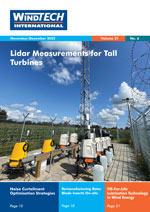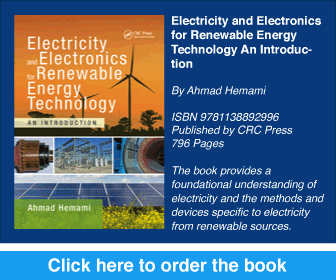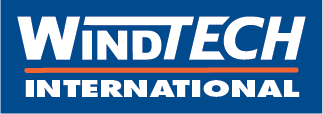- Category: Articles
A Novel Floating Offshore Wind Turbine Concept
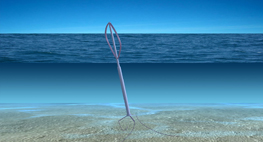 The new European targets for wind energy give a strategic role to offshore wind energy. Over the next ten years, offshore power installation is expected to grow by 28% each year (EWEA report 2009). These high expectations require a large reduction in costs and the exploitation of sites not yet suitable for offshore wind technology. It will not be possible to produce offshore wind energy by just moving current onshore wind energy technology out into shallow waters.
The new European targets for wind energy give a strategic role to offshore wind energy. Over the next ten years, offshore power installation is expected to grow by 28% each year (EWEA report 2009). These high expectations require a large reduction in costs and the exploitation of sites not yet suitable for offshore wind technology. It will not be possible to produce offshore wind energy by just moving current onshore wind energy technology out into shallow waters.
By L. Vita, U.S. Paulsen, T.F. Pedersen, H.A. Madsen and F. Rasmussen, Risø DTU Technical University of Denmark, Denmark
 The new European targets for wind energy give a strategic role to offshore wind energy. Over the next ten years, offshore power installation is expected to grow by 28% each year (EWEA report 2009). These high expectations require a large reduction in costs and the exploitation of sites not yet suitable for offshore wind technology. It will not be possible to produce offshore wind energy by just moving current onshore wind energy technology out into shallow waters.
The new European targets for wind energy give a strategic role to offshore wind energy. Over the next ten years, offshore power installation is expected to grow by 28% each year (EWEA report 2009). These high expectations require a large reduction in costs and the exploitation of sites not yet suitable for offshore wind technology. It will not be possible to produce offshore wind energy by just moving current onshore wind energy technology out into shallow waters.By L. Vita, U.S. Paulsen, T.F. Pedersen, H.A. Madsen and F. Rasmussen, Risø DTU Technical University of Denmark, Denmark
- Category: Articles
The New VDI 3834 Guideline Closes a Gap – Less Vibration is Better
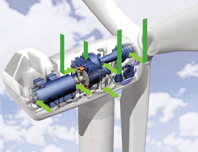 Condition-based maintenance of wind turbines not only involves maintenance but also encompasses servicing, inspection, measurement and evaluation of the condition of the unit. The current condition can be evaluated on the basis of machine-specific overall vibration values. Until now, overall vibration values had not been defined for wind turbines. In fact, ISO 10816-3 explicitly excludes wind power plants. The new VDI 3834 closes this gap, as shown in Sheet 1, which covers vibration values for wind turbines up to 3MW.
Condition-based maintenance of wind turbines not only involves maintenance but also encompasses servicing, inspection, measurement and evaluation of the condition of the unit. The current condition can be evaluated on the basis of machine-specific overall vibration values. Until now, overall vibration values had not been defined for wind turbines. In fact, ISO 10816-3 explicitly excludes wind power plants. The new VDI 3834 closes this gap, as shown in Sheet 1, which covers vibration values for wind turbines up to 3MW.
By Dr Edwin Becker, Head of Service & Diagnostic Centre, Prüftechnik Condition Monitoring, Germany
 Condition-based maintenance of wind turbines not only involves maintenance but also encompasses servicing, inspection, measurement and evaluation of the condition of the unit. The current condition can be evaluated on the basis of machine-specific overall vibration values. Until now, overall vibration values had not been defined for wind turbines. In fact, ISO 10816-3 explicitly excludes wind power plants. The new VDI 3834 closes this gap, as shown in Sheet 1, which covers vibration values for wind turbines up to 3MW.
Condition-based maintenance of wind turbines not only involves maintenance but also encompasses servicing, inspection, measurement and evaluation of the condition of the unit. The current condition can be evaluated on the basis of machine-specific overall vibration values. Until now, overall vibration values had not been defined for wind turbines. In fact, ISO 10816-3 explicitly excludes wind power plants. The new VDI 3834 closes this gap, as shown in Sheet 1, which covers vibration values for wind turbines up to 3MW.By Dr Edwin Becker, Head of Service & Diagnostic Centre, Prüftechnik Condition Monitoring, Germany
- Category: Articles
A Methodology Using Cyclone Tracking
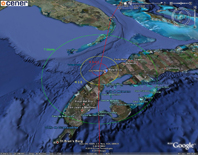 Vref is defined as the maximum 10-minute average of wind speed with a recurrence period of 50 years and is therefore one of the key parameters to be determined in the process of wind resource assessment for the planning of wind farms. Vref is directly related to extreme winds and its value decides the class of wind turbine that can be used on a site. But there is a big problem with the measurements of winds because there are no wind farms with a data record this long. Cyclone tracking provides a possible method of studying the winds experienced at a wind farm site, together with calculating a probability estimate for extreme winds. In this article we describe how CENER analysed the existing database of hurricanes, with data on wind speeds, for a period of more than 50 years.
Vref is defined as the maximum 10-minute average of wind speed with a recurrence period of 50 years and is therefore one of the key parameters to be determined in the process of wind resource assessment for the planning of wind farms. Vref is directly related to extreme winds and its value decides the class of wind turbine that can be used on a site. But there is a big problem with the measurements of winds because there are no wind farms with a data record this long. Cyclone tracking provides a possible method of studying the winds experienced at a wind farm site, together with calculating a probability estimate for extreme winds. In this article we describe how CENER analysed the existing database of hurricanes, with data on wind speeds, for a period of more than 50 years.
By Y. loureiro and P. Benito, CENER National Renewable Energy Centre of Spain, Spain
 Vref is defined as the maximum 10-minute average of wind speed with a recurrence period of 50 years and is therefore one of the key parameters to be determined in the process of wind resource assessment for the planning of wind farms. Vref is directly related to extreme winds and its value decides the class of wind turbine that can be used on a site. But there is a big problem with the measurements of winds because there are no wind farms with a data record this long. Cyclone tracking provides a possible method of studying the winds experienced at a wind farm site, together with calculating a probability estimate for extreme winds. In this article we describe how CENER analysed the existing database of hurricanes, with data on wind speeds, for a period of more than 50 years.
Vref is defined as the maximum 10-minute average of wind speed with a recurrence period of 50 years and is therefore one of the key parameters to be determined in the process of wind resource assessment for the planning of wind farms. Vref is directly related to extreme winds and its value decides the class of wind turbine that can be used on a site. But there is a big problem with the measurements of winds because there are no wind farms with a data record this long. Cyclone tracking provides a possible method of studying the winds experienced at a wind farm site, together with calculating a probability estimate for extreme winds. In this article we describe how CENER analysed the existing database of hurricanes, with data on wind speeds, for a period of more than 50 years.By Y. loureiro and P. Benito, CENER National Renewable Energy Centre of Spain, Spain
- Category: Articles
Using Advanced Weather Technology Helps Wind Farm Operators Keep Crews Safe
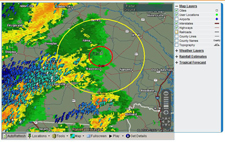 As the global demand for renewable energy continues to rise, a growing number of wind farms are providing electricity for utilities around the world. Since most wind farms are located in open, lightning-prone areas and have turbines reaching many tens of metres into the sky, lightning safety is a major concern for wind farm operators. This article will provide insight into practices that are currently being used by many leading wind farm power companies to enhance operational efficiencies and ensure employee safety.
As the global demand for renewable energy continues to rise, a growing number of wind farms are providing electricity for utilities around the world. Since most wind farms are located in open, lightning-prone areas and have turbines reaching many tens of metres into the sky, lightning safety is a major concern for wind farm operators. This article will provide insight into practices that are currently being used by many leading wind farm power companies to enhance operational efficiencies and ensure employee safety.
By Don Leick, Telvent product management director .
 As the global demand for renewable energy continues to rise, a growing number of wind farms are providing electricity for utilities around the world. Since most wind farms are located in open, lightning-prone areas and have turbines reaching many tens of metres into the sky, lightning safety is a major concern for wind farm operators. This article will provide insight into practices that are currently being used by many leading wind farm power companies to enhance operational efficiencies and ensure employee safety.
As the global demand for renewable energy continues to rise, a growing number of wind farms are providing electricity for utilities around the world. Since most wind farms are located in open, lightning-prone areas and have turbines reaching many tens of metres into the sky, lightning safety is a major concern for wind farm operators. This article will provide insight into practices that are currently being used by many leading wind farm power companies to enhance operational efficiencies and ensure employee safety.By Don Leick, Telvent product management director .
- Category: Articles
DC-Connected Hybrid Offshore-wind and Tidal-Turbine (HOTT) Generation System
This article describes a ‘Hybrid Offshore-wind and Tidal-Turbine’ (HOTT) generating system, which uses an interconnecting method to link a DC-side cluster of wind and tidal turbine generators. An interconnected combination of four tidal and one wind turbine generators is proposed, and it is anticipated that this will give an electrical output of high reliability and quality. This method is able to send generated power through a long-distance DC transmission.
By Mohammad Lutfur Rahman and Yasuyuki Shirai, Graduate School of Energy Science, Kyoto University, Japan .
This article describes a ‘Hybrid Offshore-wind and Tidal-Turbine’ (HOTT) generating system, which uses an interconnecting method to link a DC-side cluster of wind and tidal turbine generators. An interconnected combination of four tidal and one wind turbine generators is proposed, and it is anticipated that this will give an electrical output of high reliability and quality. This method is able to send generated power through a long-distance DC transmission.
By Mohammad Lutfur Rahman and Yasuyuki Shirai, Graduate School of Energy Science, Kyoto University, Japan .
- Category: Articles
Achieving a more accurate estimate of a wind resource
Many, but not all, wind farm projects do not deliver the energy production (and thus revenue) that was calculated pre-construction. Several explanations have been provided including inadequate O&M, turbines not having the expected availability and also the methodology used to calculate the long-term wind resource. This article focuses on improvements available to calculate the resource, and its potential energy production, which then feed into the financial analysis of a proposed wind farm project.
By Paul van Lieshout, Wind Power Group Manager, Sinclair Knight Merz, UK .
Many, but not all, wind farm projects do not deliver the energy production (and thus revenue) that was calculated pre-construction. Several explanations have been provided including inadequate O&M, turbines not having the expected availability and also the methodology used to calculate the long-term wind resource. This article focuses on improvements available to calculate the resource, and its potential energy production, which then feed into the financial analysis of a proposed wind farm project.
By Paul van Lieshout, Wind Power Group Manager, Sinclair Knight Merz, UK .
- Category: Articles
NREL to Develop the Next-Generation Wind Power Systems
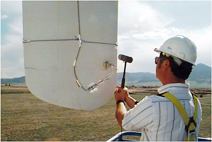 Engineers at the US Department of Energy’s National Renewable Energy Laboratory use LMS Test.Lab in performing modal testing on next-generation wind power systems. Such systems are destined to radically change America’s energy policies in the decades to come.
Engineers at the US Department of Energy’s National Renewable Energy Laboratory use LMS Test.Lab in performing modal testing on next-generation wind power systems. Such systems are destined to radically change America’s energy policies in the decades to come.
By John Krouse, LMS News Senior Contributing Editor, USA .
 Engineers at the US Department of Energy’s National Renewable Energy Laboratory use LMS Test.Lab in performing modal testing on next-generation wind power systems. Such systems are destined to radically change America’s energy policies in the decades to come.
Engineers at the US Department of Energy’s National Renewable Energy Laboratory use LMS Test.Lab in performing modal testing on next-generation wind power systems. Such systems are destined to radically change America’s energy policies in the decades to come.By John Krouse, LMS News Senior Contributing Editor, USA .
Use of cookies
Windtech International wants to make your visit to our website as pleasant as possible. That is why we place cookies on your computer that remember your preferences. With anonymous information about your site use you also help us to improve the website. Of course we will ask for your permission first. Click Accept to use all functions of the Windtech International website.



